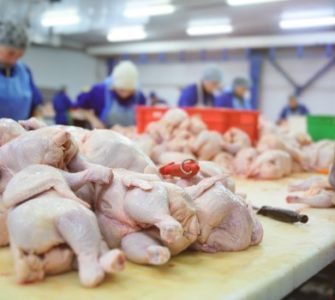Getting the best results from veterinary histopathology*
by Susan Williams, DVM, PhD, ACPV
Poultry Diagnostic and Research Center, College of Veterinary Medicine, University of Georgia, Athens, GA
Samples taken for histopathology can provide diagnostic results that are timely and inexpensive for the clinicians when done properly. For histological examination, a sample removed from an animal needs to be converted from a three-dimensional tissue into a stained section, approximately 4mm thick, adhered to a glass slide. This is examined under a microscope, essentially in two dimensions. Each stage of this sequential process is important for the final section quality, including the collection of a representative tissue sample, fixation, laboratory trimming/sampling, tissue processing, embedding, cutting, staining, mounting and, where appropriate, the use of special stains or immunohistochemistry.
The aim of fixation is to maintain fresh tissue in a state that stabilizes its architecture and chemical components in a form that enables it to be processed for histological staining and long-term preservation. Formaldehyde based fixatives are routinely used in diagnostic set-ting on the grounds of cost, efficacy, versatility and relative safety. Buffered 4 to 10% formaldehyde solutions are best, as this limit the amount of artifact requiring interpretation by the pathologist. Good fixation is easy to achieve, providing a few simple principles are applied. Formaldehyde penetrates tissue at a rate of about 5 mm per 24 hours. Therefore, material that is too thick will not be fixed in the center. This results in poor processing and that the appearance of the final histological section may not accurately reflect the underlying process. An adequate volume of fixative is also essential. In general, the volume of fixative should be at least 10 times the volume of the piece of tissue. It is best to add the tissue to the fixative to avoid one surface of the sample adhering to the wall of the container. For larger samples or multiple tissues following postmortem examination, the volume of fixative required may be too great to send through the mail. Case material can be left to fix for an adequate period of time before being submitted. Changing the fixative may be necessary to have adequate preservation of numerous tissues, bloody tissues like spleen, liver or lungs, or large tissue samples. Some organs (spleen, testes) require cutting of the capsule to allow penetration of the fixative. The excess fixative should be poured off before submission and the tissues sent to the laboratory moist with a small amount of fixative in a sealed container. It is also helpful to remember that tissues stiffen after fixation. A large soft sample that fits through a narrow opening when fresh will not necessarily fit back through the same opening once it has been fixed. This is a source of frustration and potential hazard for laboratory staff that have to remove material from the container in which it is trapped. It can also result in the specimen being damaged during removal. It is therefore important to use containers with wide lids. Some samples require a different fixative for optimum preservation. Eyeballs should be fixed in Davison solution instead of formaldehyde based fixative to decrease the amount of artifacts during fixation. Davison penetrates the tissue faster and prevents the retina from floating off the choroid and appearing like a detached retina when examined.
When a fixed sample arrives at PDRC, a technician will trim it for histological processing. Most material is processed using standard histological cassettes for presentation on standard glass slides. Standard cassettes are about 40 x 28 mm in size, which means that any submit-ted sample will be trimmed down into pieces smaller than this to enable examination. Bone samples may have to be decalcified before processing in order to be sectioned on the micro-tome which will add time to when the slides are ready for examination. Indicating what samples submitted on the form will help the technician make sure all pieces of tissue are pre-sent or if they are missing.
Routine histology processing involves dehydration of the sample using graded alcohols, permeation using a solvent (clearing agent) of equivalent density to wax and, finally, replacement of the solvent by the wax itself. The speed of this process will depend on the type of tissue, processor and reagents used. PDRC runs this process overnight, so that samples sub-mitted on one day are ready for sectioning and staining the following morning. Some tissues (bone) may require more prolonged processing. The only exception for this situation is samples submitted for ILT diagnosis. Tracheas and eyelids can be short processed and slides made the same day if the samples are here at PDRC by 11am. Once the material is permeated with wax, it is orientated for sectioning in a mould, and surrounded by molten wax. As the wax hardens, it forms a supportive block that can be mounted on a microtome and sectioned to retain the tissue architecture. Once embedded in an appropriate orientation in a wax block, the tissue is serially sectioned using a microtome until the full surface of the embedded sample is exposed. Sections of about 4 μm thickness are then cut (as ribbons of wax containing the tissue) and placed on to a warm water bath to flatten out before being laid out on glass slides. These are allowed to dry, after which the supporting matrix of wax is removed with solvents and the sections are rehydrated before staining. The routine stain used for histological examination is hematoxylin and eosin. PDRC pathologists will generally examine all tissues submitted using this stain before proceeding to any additional special stains. Once stained, sections are mounted under a glass cover slip and the mounting solution allowed to set before examination. PDRC archives copies of both the original slides produced and assessed by the pathologist and the paraffin block containing the embedded processed tissues, so that further sections or special stains can be produced at a later date. Tissues not trimmed in are kept for 30 days incase addition slides are needed.
Special stains that are available at PDRC include Giemsa, PAS, GMS, Acid Fast, Tri-chrome, Warthin Starry, Von Kossa, Brown and Hopps, and Perl’s Iron. We have immunohistochemistry for ILT. We can also cut sections for PCR from formalin fixed paraffin embedded samples in cases were fresh samples are not sent or cannot be shipped (international samples).
Additional information regarding the signalment is very helpful for interpretation of the changes seen as some are age related. Bursal sections are routinely submitted for scoring to the PDRC pathologists. However, samples from birds less than 17 days old have tremendous variation in follicle size and lymphoid content; it is difficult to determine if the changes are significant or normal variation. Information regarding any gross lesions seen during the necropsy is helpful when submitted fixed tissues. “Tissue for Histo” is not a reason for submission, it indicates the requested test. Summaries of necropsy findings (3 out of 4 birds with pneumonia, 3 out of 5 birds with bursal and thymic atrophy) will help the PDRC pathologist determine if the lesions seen are a flock problem or an individual bird problem that might be an outlier.
Below are examples of cases submitted to PDRC, both improper and proper submission of fixed tissues.

Small container has too many tissues for amount of formalin. Large contain has proper ratio of formalin to tissue. Having the proper amount of formalin solution allows penetration of the tis-sues to fix them completely. Submitted samples that are bloody usually have the formalin changed to increase the likelihood of complete fixing of the tissues.

In some cases, international samples are submitted in wax blocks. Here, the wax melted during transportation, leaving tissues exposed (white cassettes). Blue cassette demonstrates the proper amount of wax for comparison. These samples had to be re-embedded before sectioning. Problems arise if the tissues come off the submitted blocks and more than one case is submitted. Laboratory personnel may not be able to determine which case the tissue belongs to.

Samples were submitted in glass jar with a narrow top. Tissues could not be removed after fixing because they are now firm and inflexible. The jar had to be cut open with a glass cutter to remove samples.

Some samples are submitted already trimmed in cassettes. Tissue too thick for the cassette protrude through the lid and results in impression artifacts as seen in this photo. These impression artifacts can appear in the slide examined by the pathologist.
Article from The Poultry Informed Professional, Issue 126, November/December 2012
Published by the Department of Population Health, University of Georgia
Editor: Dr Stephen Collett, Associate Professor
Posted on April 17, 2014















